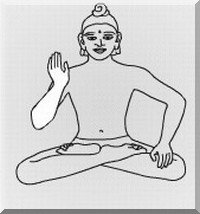|
MUDRA ABHAYA
Abhaya in Sanskrit means
fearlessness. Thus this mudra symbolizes
protection, peace, and the dispelling of
fear.
In Thailand, and especially in Laos, this mudra is
associated with the movement of the walking Buddha (also
called 'the Buddha placing his footprint'). It is nearly
always used in images showing the Buddha upright, either
immobile with the feet joined, or walking.
This mudra, which initially appears to be a natural gesture,
was probably used from prehistoric times as a sign of good
intentions - the hand raised and unarmed proposes
friendship, or at least peace; since antiquity, it was also
a gesture asserting power, as with the magna manus of the
Roman Emperors who legislated and gave peace at the same
time.
Buddhist tradition has an interesting legend behind this
mudra: Devadatta, a cousin of the Buddha, through jealousy
caused a schism to be caused among the disciples of Buddha.
As Devadatta's pride increased, he attempted to murder the
Buddha. One of his schemes involved loosing a rampaging
elephant into the Buddha's path. But as the elephant
approached him, Buddha displayed the Abhaya mudra, which
immediately calmed the animal. Accordingly, it indicates not
only the appeasement of the senses, but also the absence of
fear. |

WORLD RELIGIONS
COMPARED
WORLD
RELIGIONS CLIPART
WORLD
RELIGIONS HOME
HINDUISM HOME
MUDRA HOME |